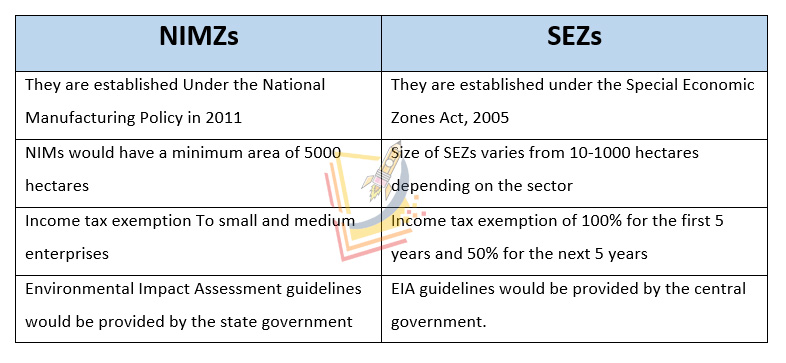INTRODUCTION
The Government of India has announced a National Manufacturing Policy with the objective of enhancing the share of manufacturing in GDP to 25% within a decade and creating 100 million jobs. THE NATIONAL INVESTMENT AND MANUFACTURING ZONES (NIMZ) are an important instrumentality of the manufacturing policy.
The Central Government will create the enabling policy framework, provide incentives for infrastructure development on a Public-Private Partnership (PPP) basis through appropriate financing instruments, and State Governments will be encouraged to adopt the instrumentalities provided in the policy
OBJECTIVES OF NATIONAL MANUFACTURING POLICY
The government of India decided to bring out the National Manufacturing Policy to bring about a quantitative and qualitative change with the following six objectives
- Increase manufacturing sector growth to 12-14% over the medium term to make it the engine of growth for the economy. The 2 to 4 % differential over the medium-term growth rate of the overall economy will enable manufacturing to contribute at least 25% of the National GDP by 2022.
- Increase the rate of job creation in manufacturing to create 100 million additional jobs by 2022.
- Creation of appropriate skill sets among the rural migrant and urban poor to make growth inclusive.
- Increase domestic value addition and technological ‘depth’ in manufacturing.
- Enhance global competitiveness of Indian manufacturing through appropriate policy support.
- Ensure sustainability of growth, particularly with regard to the environment including energy efficiency, optimal utilization of natural resources and restoration of damaged/ degraded eco-systems
SIGNIFICANCE OF NATIONAL MANUFACTURING POLICY
- India skipped the second stage of economic transition(i.e., primary sector takeover of the primary sector) and became a service economy predominantly. The manufacturing sector’s share in the Indian economy is stuck at 16%. The National Manufacturing Policy aims to increase the share of the manufacturing sector to GDP from 16% to 25% by 2022.
- This is a holistic policy for the promotion of the manufacturing sector in the country.
- NMP helps in improving the performance of Small and Medium Enterprises (SMEs) by providing incentives for their growth.
- Industrial training and skill up-gradation measures for the young workforce.
- NMP proposed rationalisation and simplification of business regulations to reduce the burden of procedural and regulatory compliance on businesses.
- It aims to set up Financial and institutional mechanisms for technology development, including green technology.
- A Special Purpose Vehicle (SPV) will be constituted by the State Government to discharge the functions specified in the policy
- Mechanisms may be developed for the cooperation of public or private institutions with government inspection agencies under the overall control of statutory authorities.
- Support to PPPs in Infrastructure in the form of capital grants at the stage of project construction will be given as per the Viability Gap Funding guidelines.
DIFFERENCE BETWEEN NIMZ AND SEZs
WHAT ARE NIMZs?
The NIMZs are envisaged as integrated industrial townships with state-of-the-art infrastructure; land use on the basis of zoning; clean and energy-efficient technology; necessary social infrastructure; skill development facilities etc. to provide a productive environment for persons transitioning from the primary to the secondary and tertiary sectors.
The main objective of Special Economic Zones is for the advancement of exports. While NIMZ is based on the idea of industrial growth that involves collaboration with the local government. NIMZ is also different from SEZ in other aspects such as level of infrastructure planning, and regulatory procedures:
WHAT ARE SEZs?
The Special Economic Zone (SEZ) policy in India was introduced in 2000 with the aim of providing a conducive environment for export-oriented production and to boost foreign direct investment (FDI). The policy provides tax holidays, duty-free import/export of goods, and other benefits to units operating within SEZs.
The policy also offers a range of facilities such as single-window clearance, relaxed labor laws, and fast-track approvals for setting up industries within the zones. The primary objective of the SEZ policy is to create an environment that encourages economic activity and attracts investment, thereby promoting economic growth and employment opportunities.
The policy has been amended several times over the years to improve its effectiveness and address various issues faced by the units operating within the SEZs. Overall, the SEZ policy in India has been successful in attracting significant investment and promoting economic growth in the country.

CONCLUSION
The National Manufacturing Policy is a policy that is implemented by a government in order to promote and support the growth and development of the manufacturing sector within the country. The goal of the policy is to increase the competitiveness of the manufacturing industry and make it a major contributor to the country's economy. The specific objectives and strategies for implementing the policy vary from country to country and can include measures such as tax incentives, investment in research and development, and training programs for workers. The success of a National Manufacturing Policy is dependent on various factors, including the political and economic environment, the level of investment and infrastructure, and the availability of skilled labor.
